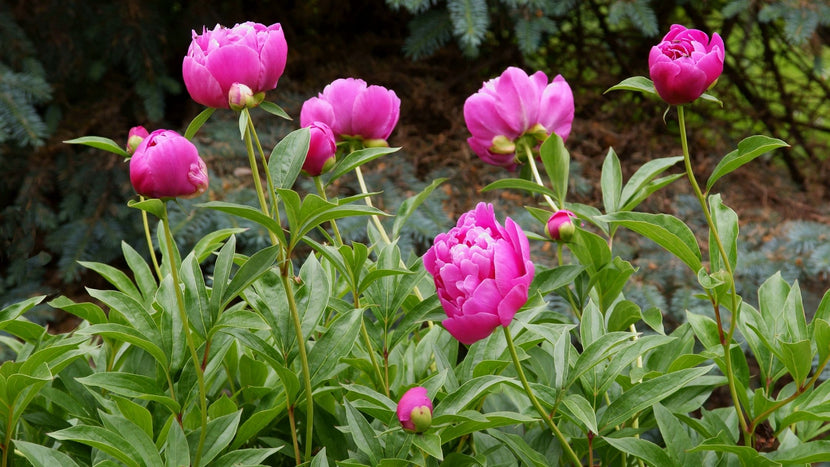How to Grow Peonies
Plant Guide

Peonies are herbaceous perennials with stunningly beautiful spring blossoms that make them a staple of bouquets and cut flower gardens. And this is a beauty that lasts; some peonies are known to last for at least 100 years! There are a few tips and tricks we have in order to make sure your peonies endure for years to come.
Not only are the flowers beautiful, many of them, such as the Duchesse de Nemours, but also have intoxicating rose-like aromas in addition to their pure white blooms. Others, such as the Karl Rosenfield feature a deep pink color that is hardly seen in other plants in the garden.
Generally, Peonies are hardy from zones 3 to 8, making their charm available for a large part of the country. They do not like to be moved once they have been established, so take caution when choosing a location. Additionally, peonies do not like to compete with other plants for supplements like sun, water, or nutrients, so they are best treated as specimen plants, placed apart from other rivaling plants.
Ground Rules
Light
These Peonies are not too particular with their sunlight requirements; they can handle full sun or partial shade and thrive beautifully. However, Peonies do grow best in full sun areas and prefer to be in the shade only during hot and bright summer hours. If you live in a colder region and plant your Peonies in the shade, doing so could result in weak stems and less flower production. If you start to notice these issues and your plant is in quite a bit of shade throughout the day, you should try to replant it in a better location for successful growth.
Water
Once established, herbaceous peonies are known to be drought tolerant. During the spring, they can survive on rainfall alone, but if your area is experiencing a gap of more than a week of rainfall, we recommend giving the plant some water to supplement.
Soil
Peonies thrive best in rich, fertile, well-draining soil conditions. These perennials like to have medium moist soil at all times, but it is critical not to let their soil get too wet and stay too wet. Make sure your plants are in well-draining soil so that they do not risk the chance of getting root rot disease. It is crucial to watch how often you water your Peony plants because too much water will oversoak their soil, but too little water won't keep them moist. It will take a bit of time to figure out the right balance for your new plant.
Food
Peonies are one of the few garden perennials that do not need fertilizer applications every year. Instead of planting them in regular soil and having to fertilize often, we recommend that you plant your Peonies with plenty of nutrients from the start. As mentioned above, your Peony plants will not bloom the first couple of years. However, once they have bloomed for a couple of years, you can apply compost, bonemeal, or well-rotted manure in early summer. Be sure not to fertilize your Peonies in the winter during their growth dormancy period. Doing so could cause their roots to burn and cause permanent damage to your plant.
Temperature
As mentioned, peonies are cold tolerant, generally hardy down to zone 3. However, it is the warmer temperatures that threaten this plant. It cannot survive above zones 8 or 9.
Toxicity
Unfortunately, peony flowers contain paenol which is known to be toxuc to animals. If eaten, it may cause an upset stomach or vomitting.
Mulch
Adding mulch around peony plants may be more damaging than it is helpful as it may smother the roots. If you live in one of the colder ends of the growing areas, it may be necessary to apply a thin, light layer of mulch around the plant to protect the roots from cold winds. Be sure to leave a space between the mulch and the base of the plant to prevent root rot.
Planting Process
It is crucial to plant your Peonies in the fall to ensure they have enough time to establish in their new home before winter and their growth dormancy period begins. It is also crucial to note that these flowers typically do not bloom the first or second year after planting. This means, do not be alarmed if the first year or two of your Peony plants, you do not see any flowers bloom. First, find a location that receives plenty of full sunlight throughout the day and with well-draining soil conditions. Once you've found your site dig a hole about 12 inches wide and the same length as your plant's roots. This is also the time to add any compost to the bottom of the hole. Next, plant your perennial's roots 1 to 2-inches below the soil level with the buds pointing upwards. Once your plant is secure, slowly back-fill around the plant's roots and compact the soil to avoid any air pockets. After your plant is planted, give it gentle watering and water every day for the first five days to ensure your plant establishes well.
How do I prune my Peony Plants?
Should I Stake My Peony Plants?
Where Should I Plant My Peony Plant?
How far apart should I space peonies?
Types of Peony Plants
| Name: | Flower Color: |
|---|---|
| Sarah Bernhardt | Light Pink |
| Shirley Temple | Light Pink and White |
| Karl Rosenfield | Hot Pink |
| Kansas | Deep Pink |
| Duchesse De Nemours | Pure White |
| Double Red | Fire-Engine Red |
| Dr. Alexander Fleming | Bubble Gum Pink |
